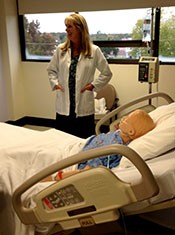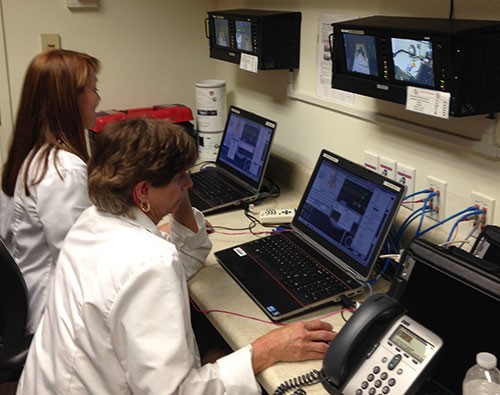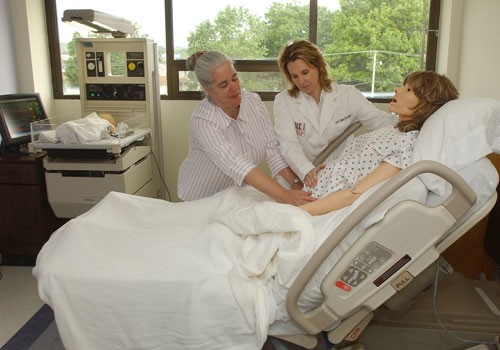Clinical Sim Center Open House demonstrates modern nursing education

RU Clinical Simulation Director Cindy Cunningham and Frankie, a mannequin masking the symptoms of sickle cell anemia, meet guests at the CSC Open House.
The Radford University Clinical Simulation Center (CSC) hosted an Open House on Oct. 21 to demonstrate the high-tech ways the School of Nursing trains regional nurses.
The RU CSC provides clinical front loading, or experience, for nursing students in a variety of settings. There are low-, medium- and high-fidelity modalities or different intensities of simulated experiences from basic caregiving skills to complicated scenarios that demand critical thinking skills, technical knowledge and human relations skills.
The CSC at the RU Corporate Park serves students from the RU campus in the School of Nursing and those from New River and Wytheville community colleges. Another center, operated by RU, is located at the Roanoke Higher Education Center (RHEC). The RHEC site serves RU nursing students there as well as students from the Jefferson College of Health Services and Patrick Henry and Virginia Western community colleges.
"Students have the ability to work through scenarios in a safe environment, do the learning and gain the experience from what they did right and wrong with an instructor," said Nursing Advisory Council Chair Marcella Griggs, who along with Former Waldron College of Health and Human Services Dean Karma Castleberry was instrumental in the development of the CSC's in 2005. The CSC is awaiting results of an accreditation process by the Society of Simulation Centers in Healthcare (SSIH) that, if successful, would make it one of 34 accredited simulation centers in the nation and the only one in Virginia.
Cindy Cunningham, CSC director, said nursing students get up to 20 percent of their required clinical hours in the lab. For licensure, nurses must have 500 hours in clinical settings prior to graduation.

In the CSC control room, Margaret Mullins (near) and Christina Keller bring the center's mannequins to life and challenge regional nursing students' nursing knowledge and patient care skills.
In the CSC, students deal with real-life health care situations and then are debriefed after the fact using the video of the encounter. Faculty critique and assess the nurse’s actions and patient skills. In addition to mannequins, the center has a cast of people, called "standardized patients" who play roles as caregivers and patients whom students will encounter as they transition into the health care workplace.
Sue Thacker is one of those standardized patients. For the open house, the retired nursing professor acted as an elderly patient who was confused over her medications in the CSC's mock home environment that exposes nurses to in-home health care.
"The first thing the young nurses want to do is clean up," said Thacker, who had strewn the kitchen with dirty dishes and old newspapers to give the room a cluttered look. "The enormity of the experience can be shocking. You can see their eyes widen as their plans go out the window."
As part of the open house, guests also met several of the CSC mannequins, including Francis, a teenage girl who was suffering from high blood sugar or possible diabetic ketoacidosis; Jasper, an elderly stroke victim, and Frank, a young boy with possible sickle cell anemia. In each case, the mannequins spoke and challenged Cunningham and the observers with symptoms and heart-rending circumstances nurses would be likely to encounter. With each simulation, student nurses get a pre-test, a post-test, a chart describing the simulated patient’s data and then the mannequin exhibits symptoms, or speaks to provide information that the student uses to respond. Upon completion of the simulated event, students and faculty review the film of the simulation for guidance as to how to do things better and for confirmation on how things were done well.

Open house guests toured the center's rooms – an assessment room in a clinic or doctor's office, a pediatric room, an Ob/Gyn room, a Med/Surg room and ICU room. They also saw the three-bed room with the latest in electronic medical records technology in which the students practice nursing fundamentals.
"Technical skills, empathy and teamwork for a nurse are so important and we can help the nurses develop them in this environment," said Cunningham, whose staff also develops and markets scenarios for use in simulation centers across the country.
The RU CSC is redlining as it has more requests to use it than it has space and personnel to accommodate. In 2014, over 1,250 students used the sites in almost 3,000 sessions for simulations of a range of medical events from congestive heart failure to depression to pediatric appendicitis. Boot camps for patient care development and testing of nursing knowledge and skills at various levels are also a part of the Center’s regimen. The center works with campus departments like the departments of Recreation, Parks and Tourism and Occupational Therapy to create and run simulations germane to their courses and with the American Heart Association to provide CPR training.